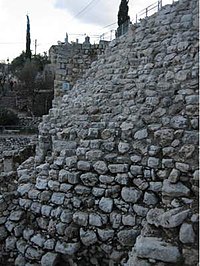
Back حصار يبوس Arabic জেবুস অবরোধ Bengali/Bangla Sitio de Jebús Spanish Siège de Jébus French כיבוש ירושלים בידי דוד HE Pengepungan Yebus ID Cerco de Jebus Portuguese Belägringen av Jebus Swedish எபூசிய முற்றுகை Tamil Yevus kuşatması Turkish
| Siege of Jebus | ||||||||||
|---|---|---|---|---|---|---|---|---|---|---|
| Part of The Military campaigns of King David (1020 BC-965 BC) | ||||||||||
 Jebusite walls in the City of David, 2006 | ||||||||||
| ||||||||||
| Belligerents | ||||||||||
| United Kingdom of Israel | Jebusites | |||||||||
| Commanders and leaders | ||||||||||
| David | Unknown | |||||||||
| Strength | ||||||||||
| Unknown | Unknown | |||||||||
| Casualties and losses | ||||||||||
| Unknown | Unknown | |||||||||
The siege of Jebus is described in passages of the Hebrew Bible as having occurred when the Israelites, led by King David, besieged and conquered the Canaanite city of Jerusalem, then known as Jebus (Hebrew: יבוס, Yəḇūs, transl. 'threshing-floor'). The Israelites gained access to the city by conducting a surprise assault, and Jebus (or Jerusalem) was subsequently installed as the capital city of the United Kingdom of Israel under its initial name as the City of David.
The identification of Jebus with Jerusalem has been challenged. Danish biblical scholar Niels Peter Lemche notes that every non-biblical mention of Jerusalem found in the ancient Near East refers to the city with the name of Jerusalem, offering as an example the Amarna letters, which are dated to the 14th century BCE and refer to Jerusalem as Úrusalim. He states that "There is no evidence of Jebus and the Jebusites outside of the Old Testament. Some scholars reckon Jebus to be a different place from Jerusalem; other scholars prefer to see the name of Jebus as a kind of pseudo-ethnic name without any historical background".[1]
- ^ Lemche, Nies Peter (2010). The A to Z of Ancient Israel. Scarecrow Press. p. 161. ISBN 9780810875654. Retrieved 3 April 2020.